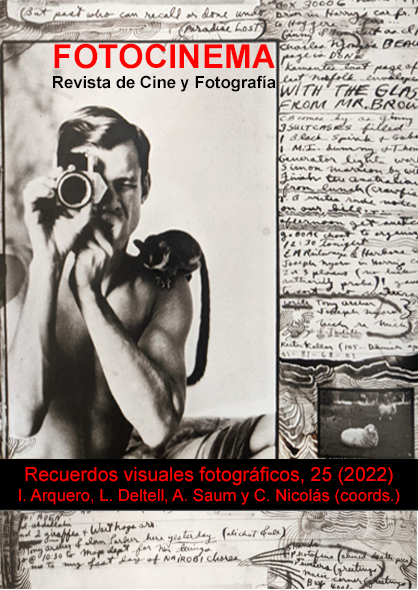Image, memory and essay in Photographs (Chus Domínguez, 2014)
DOI:
https://doi.org/10.24310/Fotocinema.2022.vi25.14479Keywords:
Documentary, Photography, Collective Memory, Film Essays, Chus DomínguezAbstract
Photographs (Chus Domínguez, 2014) is a thirty-minute video made up of photographs and discarded sound clips recorded for Territorio Archivo, a project that explored the relationships between the family photo album, memory, and the people of different Castilian villages. This article proposes an analysis focused on three aspects: the documentary value of the images and their potential for memory work, the way in which the text articulates its discursive framework, and the relevance of the essayistic features that define the essence of this work. The combination of testimonies and photographs from different private archives gives birth to a memory that lives in the present and that is individual and collective at the same time; Photographs is based on a complex discourse defined by its capacity for thought, its tendency towards the unsystematic, its subjectivity, its textual self-awareness, and its dialogical character. All these features indicate that in order to explain the discursive essence of Photographs and how it relates to the viewer, it seems more productive to read it not simply as a documentary but rather as an audiovisual essay.
Downloads
Metrics
Publication Facts
Reviewer profiles N/A
Author statements
Indexed in
-
—
- Academic society
- N/A
- Publisher
- Universidad de Málaga
References
Arquero, I. (2020). Atrapar un imposible: el ensayo audiovisual y el documental de arte en España. Escritura e imagen, 16, 43-55. http://dx.doi.org/10.5209/esim.73024
Barthes, R. (1990). La cámara lúcida. Nota sobre la fotografía. Paidós.
Casetti, F., y Di Chio, F. (1994). Cómo analizar un film. Paidós.
Cruz-Carvajal, I. (2021). Del ensayo literario al ensayo audiovisual: correspondencias y estrategias. ARBOR Ciencia, Pensamiento y Cultura, 197(801), 197-801. https://doi.org/10.3989/arbor.2021.801001
Dávila, M. (2017). Desfases del archivo o cómo construir la imagen desde la memoria (y no a la inversa). Tres casos de estudio. SOBRE. Prácticas artísticas y políticas de la edición, 3, 13-26.
Del Río, V. (2021). La memoria de la fotografía. Historia, documento y ficción. Cátedra.
Domínguez, J. (2014). Territorio Archivo: La película. Recuperado el 7 de marzo de 2022 de https://issuu.com/antoninoycinia/docs/territorio_archivo___la_pelicula___
Gómez-Isla, J. (2019). Narrativas de ida y vuelta. Apropiaciones, influencias y contaminaciones mutuas entre pintura, fotografía y cine. Fonseca, Journal of Communication, 19, 117-146. https://doi.org/10.14201/fjc201919117146
Gómez Alonso, R. (2016). Fotografía y ruina en el siglo XIX: búsqueda y rememoración del tiempo pasado. Fotocinema. Revista científica de cine y fotografía, 12, 39-60. https://doi.org/10.24310/Fotocinema.2016.v0i12.6035
González, F. (2019). Intermedialidad, institución y polisistemas. El cine como sistema dinámico: legitimación cultural e instituciones. Caracteres. Estudios culturales y críticos de la esfera digital, 8(1), 13-18.
Kuhn, A. (2007). Photography and cultural memory: a methodological exploration. Visual Studies, 22(3), 283-292. https://doi.org/10.1080/14725860701657175
Langford. M. (2001). Suspended conversations: the afterlife of memory in photographic albums. McGill-Queen’s University Press.
Langford, M. (2007). Scissors, paper, stone: expressions of memory in contemporary photographic art. McGill-Queen’s University Press.
Mínguez, N. (2012). Pensar con imágenes: tres ensayos cinematográficos. Revista de Occidente, 371, 63-82.
Mínguez, N. (Ed.) (2019). Itinerarios y formas del ensayo audiovisual. Gedisa.
Mínguez, N. y Manzano Espinosa, C. (2020). El ensayo en el audiovisual español contemporáneo: definición, producción y tendencias. Communication & Society, 33(3), 17-32. https://doi.org/10.15581/003.33.3.17-32
Oroz, E. (2020). Modos de recordar y proyectar. Fotografías (Chus Domínguez, 2014). Recuperado el 7 de marzo de 2022 de https://varsovia.cervantes.es/imagenes/File/Cultura/CINE_OTROS_MUNDOS_2020/Fotografias_Elena_Oroz_ES.pdf
Rascaroli, L. (2017). How the essay film thinks. Oxford University Press.
Downloads
Published
How to Cite
Issue
Section
License
All contents published in Fotocinema Revista científica de cine y fotografía are protected under the Creative Commons Attribution-NonCommercial-ShareAlike 4.0 International (CC BY-NC-SA 4.0) license. All about this license is available in the following link: <http://creativecommons.org/licenses/by-nc-sa/4.0>
Users can copy, use, redistribute, share and exhibit publicly as long as:
- The original source and authorship of the material are cited (Journal, Publisher and URL of the work).
- It is not used for comercial purposes.
- The existence of the license and its especifications are mentioned.
There are two sets of authors’ rights: moral and property rights. Moral rights are perpetual prerogatives, unrenounceable, not-transferable, unalienable, imprescriptible and inembargable. According to authors’ rights legislation, Fotocinema. Revista científica de cine y fotografía recognizes and respects authors moral rights, as well as the ownership of property rights, which will be transferred to University of Malaga in open access. The property rights are referred to the benefits that are gained by the use or the dissemination of works. Fotocinema. Revista científica de cine y fotografía is published in an open access form and it is exclusively licenced by any means for doing or authorising distribution, dissemination, reproduction, , adaptation, translation or arrangement of works.
Authors are responsable for obtaining the necessary permission to use copyrighted images.














13.png)



